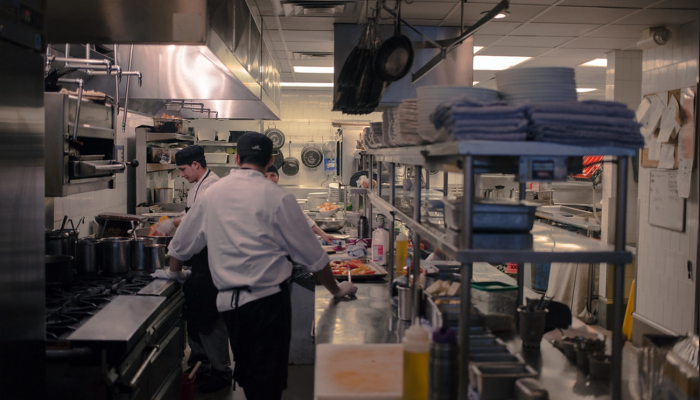This post was written by Jocelyn Chin, Civic Sustainability Fellow, with help from Helena Rudoff, Waste Reduction Programs Lead for the Office of Sustainability. Jocelyn also wrote and designed the Food Waste Management for Commercial Properties Guide and Palm Card as part of her Fellowship research.
In Philadelphia, nearly 17% of trash sent to the landfill is wasted food. This adds up to around 116 million pounds of food waste coming from commercial properties such as restaurants and other food service establishments.
Wasted food too often ends up in dumpsters, and this unused food is worth around $165 billion per year, nationally. To incentivize recycling and composting and to reduce the amount of waste sent to the landfill, City Ordinance § 10-722 (Use of Dumpsters) was amended in 2015 to state that grindable food waste (such as produce scraps, small bones, and leftovers) is not permitted to be disposed of in refuse/waste dumpsters. However, education about the rule is difficult to find online, leaving business owners without the information and tools to properly manage food waste.
In collaboration with the Natural Resources Defense Council (NRDC) Food Matters Regional Initiative, the City developed a printable and easy-to-share guide for commercial properties about the proper management of food waste in Philadelphia, with strategies listed from most to least environmentally beneficial. Food business owners can use these alternatives to dumpster disposal to reduce the amount of wasted food created and keep waste out of the landfill.
The guide lists these steps for managing food waste:
Reduce
You can prevent food waste before it’s created. In a review of 114 restaurants across 12 countries, it was found that restaurants can save $7 for every $1 invested in reducing kitchen food waste. Remember: the best food waste reduction strategy is the one that you are able to stick to. Try a variety of strategies to figure out what works best for your business and build habits over time, rather than trying to change your operations quickly. Here are some steps your business can take to reduce and repurpose food waste:
- Measure food waste
- Generate a food waste inventory to identify when, where, and how much food was wasted. The Office of Sustainability designed a spreadsheet that can help you get started
- Conduct Waste Audits yourself or with a waste consultant
- Set hard targets for waste reduction (like: reduce pre-consumer food waste by 50%) and measure your progress over time
- Rethink purchasing practices
- Compare purchasing practices with your waste inventory to inform future orders and prevent waste
- Buy imperfect or blemished foods
- Pay attention to the seasonality of produce
- Reduce consumption and waste
- Cook to order rather than batch cooking
- Store food properly to avoid spoilage and use the “first-in, first-out” method
- Evaluate and adjust portion sizes when customers often leave uneaten food on their plates
- Cut produce more efficiently to use all parts of the item
- Repurpose extra food
- Use leftover ingredients or food scraps in a creative way to avoid waste
- Create a Zero Waste special entirely using leftover food
Donate
Donation of leftover food should be pursued after taking steps to reduce wasted food, as a way to share edible foods that you cannot sell. Businesses and nonprofits that donate or distribute donated food are generally well-protected from legal burdens related to donation (such as the Bill Emerson Good Samaritan Act), and your donation may be eligible for a tax credit. Here are some quick tips for donating food:
- To be sure your donation is protected by the Good Samaritan Act, the food should be: apparently wholesome and meet all quality and labeling standards imposed by Federal, State, and local laws and regulations. Donations can be food that is not marketable due to appearance, age, freshness, grade, size, surplus, or other conditions.
- Only food with nutritional value, as determined by the Pennsylvania Department of Community and Economic Development (DCED), qualifies for a 55% donation tax credit. Some items that do not qualify are candy, soda, and snack foods, although these foods can be donated if you are not seeking a tax credit.
- Consider donating foods that are often in high demand, such as high-nutrient and culturally relevant foods, as well as prepared meals that have been stored properly to maintain safety and freshness.
- If your food is not fit to donate, you can send food scraps to a facility that treats the scraps before using them in animal feed.
Small and large amounts of food can be donated in Philadelphia through local food rescue organizations. Not sure where to start? Use the Philadelphia Recycling and Donation Finder Tool to get connected with a local food rescue organization.
Compost
Composting can happen at the household, community, or commercial scale. These processes all use food scraps to create compost, which enriches soil nutrients and increases soil health. Even further, composting can support local gardens from which you can source produce used at your business. Reach out to farms and gardens in your community to talk about partnerships that will support your shared food waste goals.
Alternatively, set up a contract to have your food scraps managed by a commercial-scale composting facility. Communicate with them to understand what you can and can’t compost. Use a separate bin or designated composting dumpster for your compost in agreement with your food scraps hauler. Not sure where to start? Use the Philadelphia Recycling and Donation Finder Tool to find a composting company near you.
Use a Garbage Disposal
Food establishments that produce grindable food waste are required to properly recycle it. When there are no other options for reducing or diverting grindable food waste, it must be disposed of using an in-sink garbage disposal/grinder and cannot be disposed of with other trash. The Philadelphia Water Department recycles the food waste you send down the drain into energy and fertilizers. Learn more about in-sink garbage disposal requirements for stationary food businesses.
Here are some dos and don’ts of using your in-sink garbage disposal:
- Fruits, vegetables, small bones, peels, and pre- and post-consumer leftovers can be disposed of through in-sink garbage disposals
- Fats, oils, and/or grease should never be put down the drain
- Any food items that are not suitable to be processed by a garbage disposal can be disposed of with regular trash
When you properly manage wasted food, your actions benefit the environment, your community, and your wallet! With less food waste sent to the landfill, business owners can help the City of Philadelphia achieve its Zero Waste goal.




